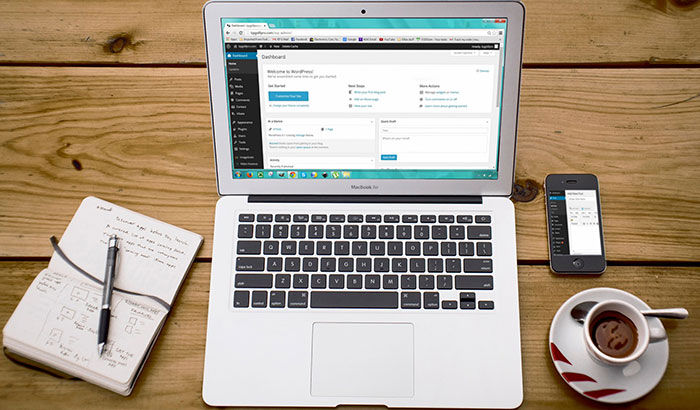
WordPress 5.0, also known as the WordPress Gutenberg editor, is finally here! This brand new editing interface finally made its debut on December 6, 2018. But what does it mean for those of us who are still using the old interface?
Change is scary, and the idea of an entirely new editor replacing what we’re used to can stir doubts and trepidation. However, we’re here to ease your fears as we dig into what you can expect with this update.
What is the WordPress Gutenberg Editor?
The WordPress Gutenberg editor is an update to WordPress’ incredibly customizable content management system (CMS). Because of this, it’s introduction is capturing the attention of everyone who uses WordPress for website design and development.
It changes the entire backend of WordPress websites, from creating new pages or design elements to uploading fresh media content. While, currently, the new editor is optional, it will eventually become the standard for WordPress users.
Everything You Need to Know About This New Release
So what can you expect out of this new CMS design? A lot, actually. The Gutenberg platform holds all the customizability of its predecessor but with improved functionality and a more intuitive interface.
Picture the clean simplicity of Medium, but with all the capabilities you know and love from WordPress.
More Intuitive Design Using Block-Based Method
WordPress is adapting to a much easier way of formatting and publishing content. Many web developers are already familiar with content blogs. They even use this method currently on WordPress through plugin integrations.
This drag-and-drop feature allows you to access a menu from a simple “+” button and select the design element you want. It’s a much more user-friendly option than WordPress’ WYSIWYG editor.
Here’s a look at a few of these block methods:
Make Easy Updates with Shared Blocks
You can also save your block templates after you create a page. This makes replicating a design such as interior page layouts easy.
If you have a shared block within your template, you can even update it across your entire website through a single action. Any changes you make to a shared block will echo through every page that uses it.
Nested Blocks Give You Control Over What Certain Blocks Can Do
As you build a new website template, there will be certain elements you create for a specific function. Nested blocks allow you to determine what that specific block is capable of doing. You can limit certain features within it so users can’t add the wrong type of content to that element.
It’s an extremely useful feature, especially if you have multiple users working in a single backend.
Parent-Child Blocks Create Content Relationships
With the introduction of child blocks, you can associate relationships between content. Child blocks only work when their parent content is present.
Incorporating API is as Simple as a Copy and Paste
What is arguably the best feature of the new Gutenberg editor is how easy it makes incorporating API. Whatever you copy from another source can be pasted as-is into WordPress. The content will immediately adapt to your site’s standard appearance.
This shaves off several steps and time for developers. For example, through Gutenberg you can copy and paste a URL into the editor without worrying about formatting and HTML.
In WYSIWYG, this is a 4 step process that includes:
- Copying the URL
- Highlighting the text you want to hyperlink
- Add the URL using the hyperlink button
- Submit the link to make it active
See what we mean? Not only is it simple, but it’s also intuitive. Users who aren’t familiar with HTML and coding will find WordPress much easier to navigate than ever before.
What the WordPress Community Has to Say
This new release isn’t without its kinks. As the WordPress community takes the WordPress Gutenberg editor for a test drive, they are discovering a number of bugs that need to be addressed.
More than 1,500 bugs, to be precise. However, the high number of tickets already submitted since its release shouldn’t worry you. Like any new program, the best way to work out the kinks is to have users put it into practice.
With each ticket, WordPress can tweak and refine the Gutenberg editor. This often happens over the course of several months, which is why WordPress isn’t officially rolling out Gutenberg as its default editor until August of 2019.
Some Users Baffled By Accessibility Being an Add-On
Accessibility is a hot topic in the digital age. This term refers to how usable a product, service, or environment is to individuals with physical disabilities. Steps have been taken to help bridge the gap in accessibility on digital platforms.
So it came as a surprise to many WordPress users when Gutenberg didn’t automatically integrate accessibility into its new editor. Instead, you have to download a plugin in order to incorporate accessibility features.
WordPress has yet to state whether this plugin is a temporary solution until they integrate these features into the editor or if they intend to keep this as a permanent solution.
However, it is worth noting that this plugin does make WordPress’ new editor interface meet accessibility guidelines.
Need Help With a Brand New WordPress Site?
The transition to WordPress Gutenberg editor is just one of the many ways this CMS keeps up with the expectations of today’s web developers. Even with kinks still being worked out, it holds all the promise and expectations one would have out of the world’s most popular platform.
Are you ready to harness its strengths by building a custom WordPress site? If so, let’s talk. Here at Digital Outlook, we design and build stunning websites that look and function in a way that compliments your business.
Contact us today to talk about your project. We’ll be happy to discuss your business goals and provide you with a quote.
